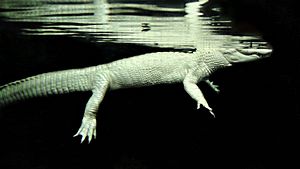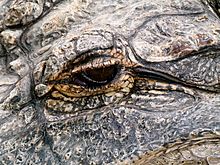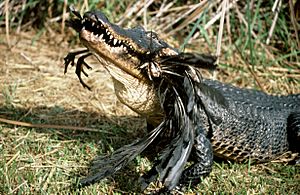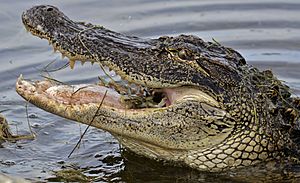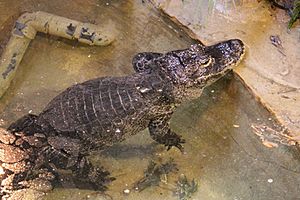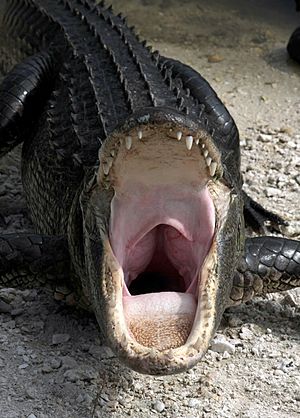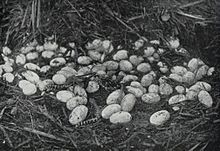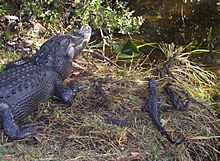Alligator facts for kids
Quick facts for kids Alligators |
|
|---|---|
 |
|
| An American alligator in captivity at the Columbus Zoo | |
| Scientific classification | |
| Kingdom: | |
| Class: | |
| Order: | |
| Family: | |
| Genus: |
Alligator
Daudin, 1809
|
| Species | |
|
Alligator mississippiensis |
|
Alligators are large reptiles that belong to the order Crocodilia. There are two main types of living alligators: the American alligator and the smaller Chinese alligator. Alligators are related to caimans, gharials, and crocodiles, and they all make up the group called Crocodilia.
Scientists believe that the first alligators lived about 37 million years ago. However, some older types of alligators are now extinct. Alligators are only found naturally in the United States and China.
Contents
What Alligators Look Like
An average adult American alligator can weigh around 358 kilograms (790 pounds). They are usually about 4 meters (13.1 feet) long. But some can grow even bigger, up to 4.3 meters (14 feet) long and weigh over 450 kilograms (990 pounds). The longest alligator ever found was in Louisiana, measuring 5.8 meters (19.2 feet) long.
There are two kinds of white alligators: albino and leucistic. These alligators are very rare in the wild. They can usually only survive in zoos or special centers. The Aquarium of the Americas in New Orleans has leucistic alligators that were found in a Louisiana swamp in 1987.
No one knows exactly how long alligators live on average. An alligator named Muja, who lives at the Belgrade Zoo in Serbia, is thought to be the oldest alligator in captivity. He is over 80 years old!
Alligators vs. Crocodiles
Alligators and crocodiles might look similar, but they have several differences:
- Alligators usually live in freshwater places like lakes and rivers. Crocodiles have special glands that let them live in saltwater.
- Most alligators have wide, U-shaped snouts. Crocodiles usually have longer, narrower, V-shaped snouts.
- When an alligator closes its mouth, you cannot see its fourth tooth on the lower jaw. When a crocodile closes its mouth, you can usually see this tooth sticking out.
Where Alligators Live
Alligators are native to the United States, Mexico, and China.
American alligators are found in the southeastern United States. This includes all of Florida and Louisiana. They also live in parts of Georgia, Alabama, Mississippi, South Carolina, North Carolina, East Texas, Oklahoma, and Arkansas. Louisiana has the most alligators. Florida and Louisiana each have over a million alligators. Southern Florida is the only place where both alligators and crocodiles live together. A small group of alligators is also found in Tamaulipas, Mexico.
American alligators prefer freshwater places. These include ponds, marshes, wetlands, rivers, lakes, and swamps. They can also live in brackish water, which is a mix of fresh and salt water. Alligators help their environment by digging "alligator holes" in wetlands. These holes create homes for other animals and help plants grow, especially during dry times. They also help control the number of animals like coypu and muskrats, which can damage wetlands.
The Chinese alligator lives only in the Yangtze River valley in China. This species is very endangered, with only a few dozen left in the wild. Many more Chinese alligators live in zoos around the world than in their natural habitat. Places like Rockefeller Wildlife Refuge in Louisiana and Miami MetroZoo in Florida are working to help this species survive.
What Alligators Eat
Alligators often move slowly, but they can run very fast for short distances. They are especially quick when lunging at prey. Alligators usually hunt smaller animals that they can eat in one bite. If an animal is too big, they might drag it into the water to drown it. They also use a move called a "death roll." This is when they bite their prey and spin around quickly to tear off bite-sized pieces.
American Alligators
American alligators mainly live in the southeastern United States. Louisiana has the largest alligator population, with about two million. Florida is home to about 1.3 million alligators. Southern Florida is the only place where both alligators and crocodiles live side by side.
American alligators cannot live in saltwater for long. This is because they do not have salt glands like crocodiles. So, they live in freshwater places. These include ponds, marshes, wetlands, rivers, lakes, and swamps. They can also be found in brackish environments.
Chinese Alligators
Chinese alligators are smaller than American alligators. They are rarely longer than 2.1 meters (6.9 feet). They also weigh much less than American alligators. Male Chinese alligators usually weigh less than 45 kilograms (99 pounds). The Chinese alligator is currently found only in Eastern China. They live in a small area of the Yangtze River basin.
The Chinese alligator is extremely endangered. Scientists believe there are only a few dozen left in the wild. Many more Chinese alligators live in zoos around the world than in their natural home. The Rockefeller Wildlife Refuge in southern Louisiana keeps some in captivity to help save the species. Miami MetroZoo in Florida also has a pair of Chinese alligators that are part of a breeding program.
How Alligators Behave
Large male alligators usually live alone. They are territorial and will fight to protect their best hunting grounds. Smaller alligators, however, can often be found living close together in large groups.
Alligators move on land in two ways. One is the "sprawl," where their belly touches the ground as they slide forward. This is used to move over wet surfaces and into water. The other is the "high walk," where they lift their body off the ground on all four legs. This is for traveling over land. Alligators have also been seen standing on their back legs for a short time to lunge forward. But they cannot walk on their back legs for long distances.
Most of the muscles in an alligator's jaw are for biting and holding prey. The muscles that close their jaws are incredibly strong. But the muscles that open their jaws are quite weak. Because of this, an adult human can hold an alligator's jaws shut with bare hands. People often use strong tape to keep an adult alligator's jaws closed when they need to handle or move it.
Alligators are usually shy around humans. They tend to swim or walk away if a person comes near. In Florida, it is against the law to feed wild alligators. If fed, alligators can lose their fear of humans. They will then start to connect people with food. This makes them more dangerous to people.
How Alligators Reproduce
Alligators usually become adults when they are about 1.8 meters (6 feet) long. The mating season is in late spring. In April and May, alligators make loud "bellowing choruses." Large groups of alligators bellow together for a few minutes, several times a day. This usually happens one to three hours after sunrise. Male American alligators also make very low sounds that humans cannot hear. Another way males show off is by loudly slapping their heads on the water. Recently, scientists have seen alligators gathering in large groups at night in spring for group courtship, which they call "alligator dances."
In summer, the female alligator builds a nest out of plants. The rotting plants create heat, which helps to incubate the eggs. The temperature inside the nest decides if the baby alligators will be male or female. This is set within seven to 21 days after the eggs are laid. If the temperature is 30 degrees Celsius (86 degrees Fahrenheit) or lower, mostly females will hatch. If the temperature is 34 degrees Celsius (93 degrees Fahrenheit) or higher, mostly males will hatch. Nests made on leaves are hotter than those in wet marsh. So, leaf nests tend to produce males, while wet marsh nests tend to produce females. Baby alligators have a special "egg tooth" that helps them break out of their eggs.
Naturally, for every male alligator that hatches, there are five females. Female hatchlings weigh more than males. The mother alligator protects her nest from animals that might try to eat the eggs. She also helps the baby alligators get to the water. She will protect her young for about a year if they stay in the area. The biggest danger to young alligators is adult alligators.
How Alligators Help Humans
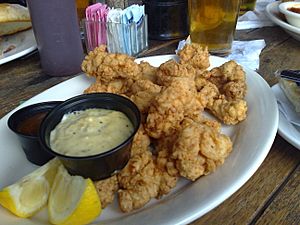
Alligators are raised on farms for their meat and skin. Alligator skin is used to make things like bags and shoes. Alligators also help the economy through tourism. Visitors can take swamp tours where they can see alligators. Their most important benefit to humans might be controlling animals like coypu and muskrats. Louisiana spends a lot of money to control coypu using alligators.
Alligator meat is also eaten by humans. The meat is often described as tasting like fish.
Protected Status
American alligators were once an endangered species in the United States. Today, they are no longer endangered. However, they are still a "protected species." They are protected because they look similar to some types of crocodiles and caimans, which are still endangered. The Fish and Wildlife Service lists the American alligator as “threatened due to similarity of appearance.”
The goal of this protection is to stop people from accidentally killing endangered crocodiles and caimans. This happens when people mistake them for alligators. Because of this, killing alligators and selling products made from alligator meat or skin are controlled by the Fish and Wildlife Service.
Interesting Facts About Alligators
- Alligators are smart. They have been seen holding sticks and branches on their heads. They do this to trick birds looking for materials to build their nests.
- Alligators do not have vocal cords, but they use many different calls to talk to other alligators.
- Alligators never stop growing throughout their lives.
- They can eat almost a quarter of their own body weight in just one meal.
- An alligator’s stomach can dissolve bone. This means they do not need to eat around the bones of their prey.
- Alligators eat more than just meat. They also like to eat fruit.
Images for kids
-
An 1854 watercolor painting of an alligator from the Cayman Islands by Jacques Burkhardt.
-
Alligator in the Everglades National Park
-
Alligator in the Canberra Zoo in Australia
See also
 In Spanish: Lagartos para niños
In Spanish: Lagartos para niños


